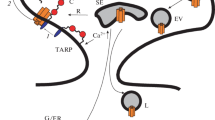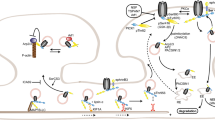Abstract.
Modification of ligand-gated receptor function at the postsynaptic domain is one of the most important mechanisms by which the efficacy of synaptic transmission in the nervous system is regulated. Traditionally, these types of modifications have been thought to be achieved mainly by altering the channel-gating properties or conductance of the receptors. However, recent evidence suggests that AMPA (α-amino-3-hydroxyl-5-methyl-4-isoxayolepropionic acid)-type ligand-gated glutamate receptors are continuously recycling between the plasma membrane and the intracellular compartments via vesicle-mediated plasma membrane insertion and clathrin-dependent endocytosis. Regulation of either receptor insertion or endocytosis results in a rapid change in the number of these receptors expressed on the plasma membrane surface and in the receptor-mediated responses, thereby playing an important role in mediating certain forms of synaptic plasticity. Thus, controlling the number of postsynaptic receptors by regulating the intracellular trafficking and plasma membrane expression of the postsynaptic receptors may be a common and important mechanism of synaptic plasticity in the mammalian central nervous system.
Similar content being viewed by others
Author information
Authors and Affiliations
Rights and permissions
About this article
Cite this article
Man, HY., Ju, W., Ahmadian, G. et al. Intracellular trafficking of AMPA receptors in synaptic plasticity. CMLS, Cell. Mol. Life Sci. 57, 1526–1534 (2000). https://doi.org/10.1007/PL00000637
Published:
Issue Date:
DOI: https://doi.org/10.1007/PL00000637




